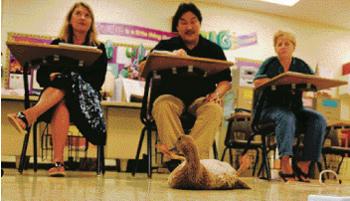KAPA‘A — The ducky weather Monday afternoon did not bother Sonya Tupou Bonilla in the slightest.
In fact, Sonya’s owner, Kapa‘a High School senior Mark Bonilla, had to demonstrate the duck’s “time out” position because Sonya was so excited about the raindrops that created puddles of water around the Eastside campus.
Sonya is a duck that Mark Bonilla hatched from an egg and raised as part of his senior project on animal behavior, specifically demonstrating the imprinting principle.
She was with Mark Bonilla as part of his presentation before a panel of judges.
“We have more than 200 presentations taking place today,” said Keith Amano of the school’s computer lab. “I have to stand by because some of the students have their presentations in the new Windows format and the school’s system can’t read that. They come to me in a panic and we have the converter that allows the presentation to be read by the school’s system.”
Kapa‘a High School teacher Margaret Clapp said the senior project is a graduation requirement for every senior.
Monday was a Collaboration Day for Kapa‘a High School, a day when students other than the 12th graders were not required to be in school — allowing the faculty to serve on the various panels that reviewed the presentations.
“The senior project combines rigor and relevance to engage students in their senior year,” said Janis Gowan, an English teacher at Kapa‘a High School. “It provides student work for the real world and gives them a voice in their own learning.”
There are four parts to the senior project: the paper, the product/project, the presentation and the portfolio.
“It’s kind of like when you go for your masters degree and you need to defend your subject before a panel of judges,” Clapp said. “We get to see how much the students know and how much they’ve learned.”
The first step is for the student to select a topic. This allows the student the opportunity to follow a passion, explore a dream or express a talent that traditional curriculum would restrict, Gowan said.
Students then need to find a mentor, someone who is somewhat of an expert on the topic, to help guide them.
In Sonya’s case, Bonilla said he pretty much learned on his own and Gowan became his mentor, serving as a source when he had questions.
The research phase nudges the students out of their comfort zones, going beyond books and the Internet. Students conduct personal interviews and conduct surveys, the results of which are included into a research paper of between five to eight pages in length.
“I had to go through two different sources for duck eggs since that is not something you can easily find on Kaua‘i,” Bonilla said. “We went through at least 38 eggs before Sonya was hatched.”
The project itself allows the student to select between job shadowing, community service or creating a product, Gowan said. The students must devote a minimum of 15 hours to their selection.
During this time, students write four smaller papers reflecting on the process and what they are learning along the way.
“There was only one fertile egg in all the eggs we worked through,” Bonilla said. “It had to hatch or I wouldn’t have a project.”
During the process, Bonilla enlisted the aid of his father who helped construct the many pieces of equipment needed to bring Sonya into the world.
There was a lot of information that Bonilla learned such as the candling process where a light is used to see if an embryo is developing inside the egg.
Gowan said the most challenging part of the project for the students is the presentation when they get up in front of a panel of faculty and community members and explain their research and project, fielding questions from panel members and the portfolio serving as the evidence of their accomplishments.
“One of the biggest things I learned is being responsible for someone else’s life,” Bonilla told the panel. “I also learned what it’s like to be a parent, taking care of an animal, being patient and communication skills because I had to defend Sonya to everyone who thought the project was not smart.”
But raising Sonya, including taking two days off from school when he discovered the first stages of hatching, had its rewards as Sonya accompanied Bonilla to several soccer practices and even was on hand at the final JV soccer game where the Kaua‘i High School players fell in love with her, he said.
The senior project covers all the state standards, but more importantly, leaves students with a sense of accomplishment and pride, Gowan said.
“Today, Sonya is five months old,” Bonilla said. “She came out of her shell on Nov. 20.”
• Dennis Fujimoto, photographer and staff writer, can be reached at 245-3681 (ext. 253) or dfujimoto@kauaipubco.com


